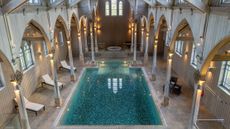The attraction of Colebrooke Row – Islington
Boris Johnsons’ street in Islington used to have a river running down it, and was home to writer and essayist Charles Lamb

Boris Johnsons’ street in Islington used to have a river running down it, and was home to writer and essayist Charles Lamb
For my latest blog, I’ve been inspired by the recent discussion about Boris Johnson and his choice of home in Colebrooke Row in Islington. It just so happens that I’ve researched the history of this pretty Georgian street, which actually hasn’t changed much since the buildings first appeared in the 18th century.
Today, Colebrooke Row is one of the most sought after addresses in London, but in the early 18th century it was covered in fields and farm land. Most particularly, it was also the path of the New River, which ran down the centre of the street and the only homes were small river side cottages. The building of the familiar terraced rows began in the 1760s, however, like much of the building at this time, it appeared in stops and starts with a number of different builders.
Slowly, building continued to extend down Colebrooke Row throughout the late 18th century, but even by the 1790s much of the west side of the New River (that still ran down the centre of the street) was undeveloped. The only home on this side was Colebrooke Cottage, the home of Charles Lamb and his sister Mary from 1823 to 1827. Charles Lamb was a writer and essayist who entertained a number of eminent literary men in his home, including John Keats, William Wordsworth and Samuel Taylor Coleridge. Although, with the house being so close to the river, it was unfortunate that a guest visiting Mary Lamb (without his glasses) happened to walk straight out the front door into the river running along the front of the house! He was pulled out safely, but Charles Lamb took the opportunity of the incident by writing about it in his next essay in the London Magazine.
Building continued along Colebrooke Row during the 19th century, with much of the street completed by the 1830s and 40s, at which point new streets, such as Elia Street, Vincent Terrace and Noel Road began to appear off Colebrooke Row.
Although the New River was eventually filled in (giving Colebrooke Row the unusual long central gardens), today, Colebrooke Row still retains many of the original Georgian homes and its picturesque appearance, which explains why the residents are so proud of it.
Chesterton Humberts are selling a unique new development sympathetically designed to compliment the neighbouring Georgian homes. Find out more about the Colebrooke Collection .
Sign up for the Country Life Newsletter
Exquisite houses, the beauty of Nature, and how to get the most from your life, straight to your inbox.
* For a full history of Colebrooke Row and the surrounding streets visit my blog.
Country Life is unlike any other magazine: the only glossy weekly on the newsstand and the only magazine that has been guest-edited by HRH The King not once, but twice. It is a celebration of modern rural life and all its diverse joys and pleasures — that was first published in Queen Victoria's Diamond Jubilee year. Our eclectic mixture of witty and informative content — from the most up-to-date property news and commentary and a coveted glimpse inside some of the UK's best houses and gardens, to gardening, the arts and interior design, written by experts in their field — still cannot be found in print or online, anywhere else.
-
 If heaven is on earth, it might be in this home with a converted chapel that is now a swimming pool
If heaven is on earth, it might be in this home with a converted chapel that is now a swimming pool5 Wood Barton Town House is part of an exclusive 80-acre development in Devon that also comes with fishing rights on the River Avon and four bedrooms.
By James Fisher Published
-
 An Italian-inspired recipe for lemon-butter pasta shells with spring greens, ricotta and pangrattato
An Italian-inspired recipe for lemon-butter pasta shells with spring greens, ricotta and pangrattatoSpring greens are just about to come into their own, so our Kitchen Garden columnist reveals exactly what to do with them.
By Melanie Johnson Published

